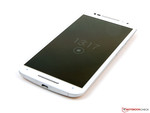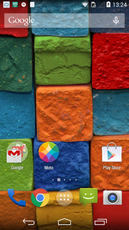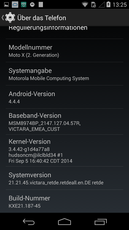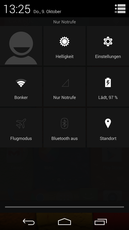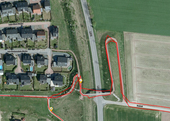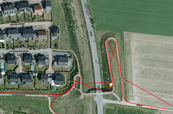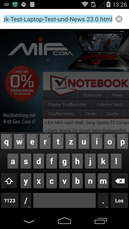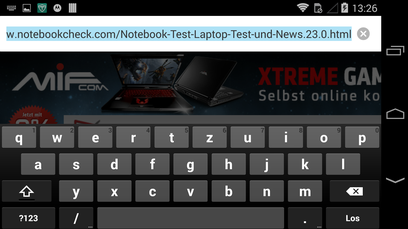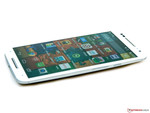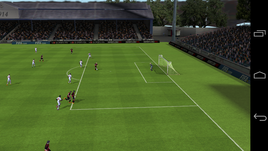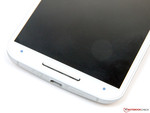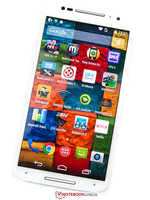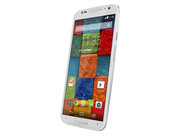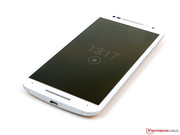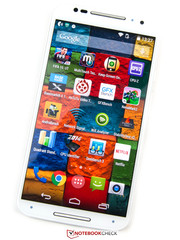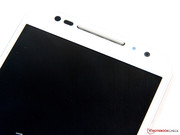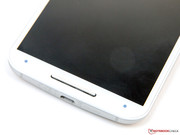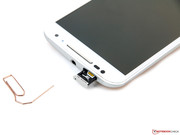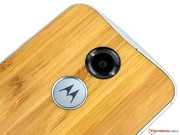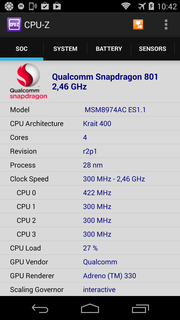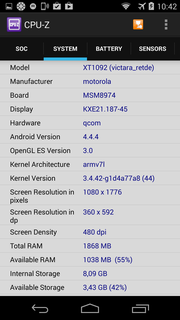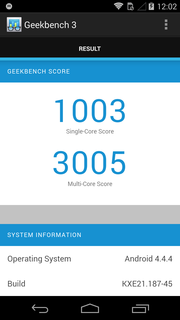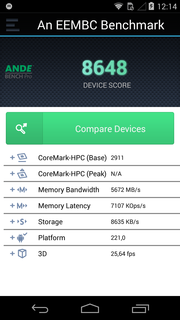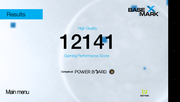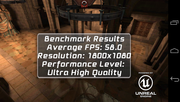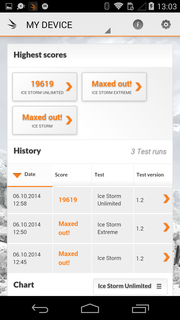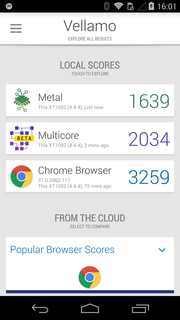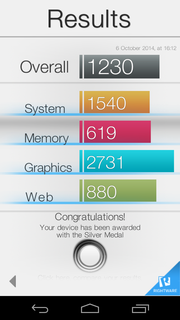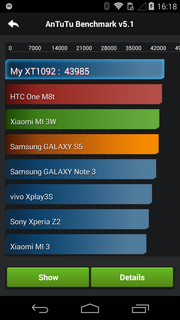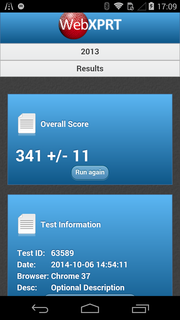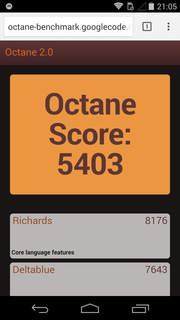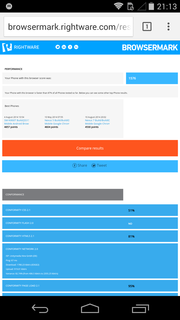Motorola Moto X (2014) Smartphone Review
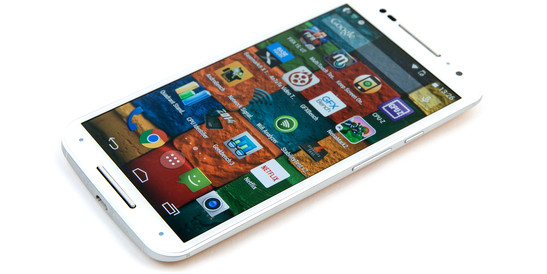
For the original German review, see here.
Motorola has revamped its Moto X and greatly improved it compared to the precursor. Whereas the first-generation flagship smartphone featured a Snapdragon S4 Pro, 1.5 GB of RAM, a 720p screen, and a 10 MP camera, the technical specs have been adapted to the current state-of-the-art without using superlatives. The swift Snapdragon 801 is very fast, but it is not the present top model from Qualcomm. A Full HD screen has grown to fit the bigger 5.2-inch screen diagonal, but it cannot compete with the quad-HD resolution of an LG G3. Instead of relying on technical superlatives, Motorola focuses on user experience and the smartphone's individual design options that are not found to this extent among the competition.
The smartphone is easy to personalize online via the Moto maker's website and is available for a price starting at 529 Euros (~$674). Buyers who want a leather or wooden back cover have to invest 20 Euros (~$25) more. Besides that, a storage expansion to 32 GB also costs 50 Euros extra (~$63), which can boost the price of the Moto X up to 599 Euros (~$764).
The contenders are wide-ranging. In addition to Android smartphones such as Samsung's Galaxy S5 (starting at 430 Euros, ~$548), Sony's Xperia Z3 (starting at 610 Euros, ~$778), HTC's One M8 (starting at 530 Euros, ~$676), or LG's G3 (starting at 430 Euros, ~$548), devices like Apple's iPhone 6 Plus with iOS (starting at 800 Euros, ~$1020) and Nokia's Lumia 930 based on Windows Phone (starting at 420 Euros, ~$535) also belong to the list of contenders.
Case
The casing of the new Motorola Moto X has been completely reworked while maintaining the ergonomic design. The back is curved with a thickness of just 3.8 millimeters at the outer edges increasing to 9.9 millimeters toward the smartphone's middle. The weight of 145 grams is acceptable.
We like the option of personalizing the Moto X on Motorola's website when ordering it online. The front is available in white and black. Choosing the back is more difficult. The customer has the option of 17 different plastic covers and four leather or wood back covers. The speaker parts and the ring around the Motorola logo can also be designed in color. Like Apple, the device can be etched individually.
The design's high flexibility has a negative impact on the gaps though. Our review sample features a wooden back cover that does not close evenly with the impeccable aluminum bezel. The speaker components on the front also exhibit a wide gap to the Corning Gorilla Glass 3 pane so that dirt will quickly accumulate here. However, the stiffness of the Moto X is very good, and only a quiet cracking noise can be evoked.
The nano-SIM slot closes flush with the aluminum bezel, but it is difficult to open. There is no slot for expanding the storage, and the battery is not removable. Though the device does not have an IP certification, the nano-coating protects the smartphone against splash water and thus accidentally spilled liquids or rain will not harm it.
Connectivity
The USB 2.0 port on the lower edge of Motorola's Moto X is for recharging the smartphone as well as for transferring data to a computer. The interface supports OTG so that USB sticks and input devices can be connected to the device via an optional adapter. However, MHL for video transmission is not supported. Wireless video transmission is possible via Miracast.
Software
The operating system in Motorola's Moto X is Google's Android 4.4.4 KitKat, which is presently the latest version. It has not been modified, and Motorola promises that the smartphone will be provided with timely updates to the newest Android versions.
Additional software is scarce. Only Quickoffice is preloaded, next to some proprietary apps from Motorola that are to help with managing and controlling the smartphone.
Communication & GPS
Motorola's Moto X has a Wi-Fi module that supports the IEEE 802.11 a/b/g/n/ac standards and can thus transmit in both the 2.4 and 5.0 GHz frequency bands. The components' range is satisfactory. The connection was stable even at a distance of 20 meters from the router (Fritz!Box 6360, 2.4 GHz), though very weak. Lags were not noticed when setting up websites.
The Internet can be accessed via HSPA+ (max. 42 Mbps downstream) or LTE Cat. 4 (max. 150 Mbps) using the mobile data connection. LTE Cat. 6 is not yet supported. The high frequency coverage is pleasing, and there should not be any inconveniences in European countries.
Bluetooth 4.0 LE is also installed and provided good results in pure audio streaming. However, users who stream videos from the Internet and would like to transmit the sound via an external speaker will discover that the sound is not in sync. Additionally using a smartwatch might burden the Bluetooth connection even more.
The Moto X uses GPS and GLONASS for localization. Satellites are found virtually immediately outdoors. We also recorded a still useful signal indoors.
The smartphone's accuracy is noticeably worse than that of the Garmin Edge 500 bike computer. According to the review sample, we drove roughly 720 meters further, which equals a difference of about 7%. A clear deviation from the driven route in difficult situations is seen when looking closer at the route tracking. However, the altitudes recorded by the Moto X are relatively exact so that a decent, though not outstanding, overall impression is made.
Telephony & Voice Quality
The voice quality of Motorola's Moto X is absolutely impressive when it is held directly to the ear. Speech was transmitted clearly and free of any audible interference on both sides. There is no reason for complaint here. However, when the speaker was used, short speech interruptions were sometimes noticed on the review sample's side, while our contact sounded a bit tinny and the sound resonated strongly.
The phone app's design is straightforward. It is convenient that the app starts with a history page that displays the last number called. A speed-dial view that lists up to four contacts is below that. They are arranged in tiles and can be sorted as pleased.
Cameras
Motorola's Moto X has two cameras. The front-facing lens provides a resolution of 2 MP (1920x1080 pixels, 16:9). It shoots useful pictures in good light conditions as long as the user only uses it for social networking and messenger apps; its videoconferencing properties are decent.
The smartphone's primary camera has a resolution of up to 13 MP (4160x3120 pixels, 4:3) and delivers good results in daylight. However, images are slightly overexposed so that some details are lost. It also affects the sharpness and details look frayed. The color reproduction is quite natural and hardly gives reason for complaint.
The camera in the Moto X soon finds its limits in the low-light range. Details look blurred and very strongly faded. The results are still better than with an iPhone 6. Nearby objects are illuminated too strongly and even grains of dust become overly visible when the ring flash with two LEDs is used. The pictures look noisy as well.
The Moto X records videos in either Full HD (1920x1080 pixels) or Ultra HD (3840x2160 pixels) with 30 frames per second in both cases. This cannot be changed in the settings, which is too bad because the European PAL format relies on 25 or 50 frames per second. The quality is decent but decreases considerably in low light. The lens does not deal well with motion either. The smartphone also offers a slow motion mode in 1080p, but we would not recommend it because it simply halves the frame rate. Firstly, this is not superb slow motion, and secondly it leads to a poor picture result with streaks because 15 fps is simply too little.
Thus, the Moto X certainly does not offer a bad camera, but it is not a gadget for enthusiasts. It cannot compete with top lenses like in the LG G3, Galaxy S5 or Lumia 1020.
Accessories
The included accessories for Motorola's Moto X only encompass a modular power supply and the corresponding data cable. Unfortunately, we received the smartphone without any accessories so that we do not have a detailed overview of the articles. The manufacturer still does not include a headset.
Motorola does not offer optional accessories for its flagship. Only the Moto 360 smartwatch can be named, but this was not available in Germany at the time of the test.
Warranty
Motorola includes a 24-month warranty on its smartphone that cannot be upgraded.
Input Devices & Controls
The capacitive touchscreen of Motorola's Moto X makes a good impression and detects up to ten touch points at the same time. The surface is suave, and it implements inputs quickly and accurately. Android's stock keyboard layout is used and does not have any special features.
Motorola focuses on voice control and resorts to Google Now. However, the Moto X is still the only smartphone that uses a dedicated always-on audio processor to receive voice commands in standby. This is particularly convenient when driving a car because voice control is enabled via a key sentence or word. The exclamation "OK Google!" is known from other devices and could also be used with the review sample. However, a personalized trigger can be selected in the Moto X. That functioned quite well in practice, even in slightly louder surroundings. Google Now is expanded by handy commands. For example, the smartphone can be set to emit a high-pitched sound via "find phone" or night mode can be enabled with "good night" or reactivated via "good morning."
The Moto X detects approaches from a distance of 15 centimeters via three infrared sensors. Information, such as the time, missed calls and messages, can be displayed on the screen. The sensors can also be used for reducing the ringtone volume for incoming calls or snoozes the alarm clock by waving a hand over it.
Display
Motorola again relies on an AMOLED screen. However, it now has a resolution of 1920x1080 pixels (Full HD), which leads to a pixel density of approximately 424 ppi in a screen size of 5.2-inches. Thus, the displayed content looks razor-sharp.
The maximum brightness of 278 cd/m² is even lower than in the precursor (max. 320 cd/m²), and it is the lowest in the comparison field. Although OLED screens are generally not as bright as LCD screens, even other devices with AMOLEDs are brighter. Samsung's Galaxy S5 is clearly above that with 401 cd/m², and the Lumia 930 still reaches up to 297 cd/m². The illumination of 91% in the Moto X is very good, but again we find a deterioration compared with last year's model (97%). We did not notice halos.
| |||||||||||||||||||||||||
Brightness Distribution: 91 %
Center on Battery: 259 cd/m²
Contrast: ∞:1 (Black: 0 cd/m²)
ΔE Color 6.52 | 0.5-29.43 Ø5
ΔE Greyscale 3.05 | 0.57-98 Ø5.3
Gamma: 2.31
| Motorola Moto X 2. Gen 2014 Adreno 330, 801 MSM8974AC, 16 GB eMMC Flash | Nokia Lumia 930 Adreno 330, 800 MSM8974, 32 GB eMMC Flash | Samsung Galaxy S5 Adreno 330, 801 MSM8974AC, 16 GB eMMC Flash | Apple iPhone 6 Plus PowerVR GX6450, A8, 64 GB eMMC Flash | HTC One M8 Adreno 330, 801 MSM8974AB, 16 GB iNAND Flash | |
|---|---|---|---|---|---|
| Screen | -46% | 7% | 42% | 22% | |
| Brightness middle | 259 | 275 6% | 358 38% | 519 100% | 474 83% |
| Brightness | 263 | 278 6% | 364 38% | 496 89% | 486 85% |
| Brightness Distribution | 91 | 89 -2% | 82 -10% | 90 -1% | 93 2% |
| Black Level * | 0.62 | 0.54 | |||
| Colorchecker dE 2000 * | 6.52 | 10.99 -69% | 5.28 19% | 3.67 44% | 5.86 10% |
| Greyscale dE 2000 * | 3.05 | 8.29 -172% | 4.65 -52% | 3.78 -24% | 5.2 -70% |
| Gamma | 2.31 95% | 2.16 102% | 2.48 89% | 2.42 91% | 2.29 96% |
| CCT | 6226 104% | 6731 97% | 7690 85% | 7327 89% | 7218 90% |
| Contrast | 837 | 878 |
* ... smaller is better
The user is presented with a deep black due to the OLED technology used in Motorola's Moto X, without a sign of glowing. This results in a contrast ratio that theoretically tends to infinity. LCD-based smartphone screens cannot compete here. Black surfaces in the iPhone 6 Plus (0.62 cd/m², 837:1) and HTC's One M8 (0.54 cd/m², 878:1) always look more charcoal black.
The color accuracy already indicates what the color saturation assessment confirms. The colors on the screen of the Moto X are extremely over-saturated. While the grayscale (max. dE 5) still makes a really good impression, the mixed colors (max. dE 12) show a visible shift. This will not bother friends of AMOLED technology, but users who put value on a natural color reproduction are backing the wrong horse in this case. The Galaxy S5 does a considerably better job here by providing different color profiles, which also enables natural color reproduction. It is pleasing that the Moto X only has a minor yellowish cast.
Motorola's Moto X makes a mixed impression in outdoor use. The screen suffers under its comparatively low brightness. The excellent contrast cannot compensate for this in the sun, particularly since the glass surface is highly reflective. All this is no problem in the shade or cloudy conditions, but it looks different in direct sunlight. Sun worshipers will be pleased that the phone can read their messages aloud.
The viewing-angle stability of Motorola's Moto X is quite good owing to the underlying AMOLED technology. However, minor losses have to be made in extremely flat viewing angles owing to the reflective surface. Besides that, a visible greenish cast covers the displayed content starting at an angle of approximately 45 degrees, which is also sometimes annoyingly noticed in practice.
Performance
Motorola's Moto X is based on the swift Qualcomm Snapdragon 801 MSM8947AC SoC that has four processor cores with a clock rate of up to 2.45 GHz each. Alongside the 2 GB of working memory, the powerhouse provides plenty of performance and smooth operation of Google's Android 4.4 KitKat. It is only too bad that Motorola does not use the option of multitasking. The system would certainly be strong enough for that. The integrated Qualcomm Adreno 330 takes care of graphics calculations. It clocks with up to 578 MHz.
The Moto X is absolutely convincing in the benchmarks and leads the rankings in the comparison field. It only does not quite achieve the graphics performance of the iPhone 6 Plus. The iPhone is also the leader in single-core operations. Nevertheless, the review sample promises superb performance scores that are currently only surpassed by devices with a Tegra K1 or Snapdragon 805.
| AnTuTu v4 - Total Score (sort by value) | |
| Motorola Moto X 2. Gen 2014 | |
| Motorola Moto X 1. Gen 2013 | |
| Google Nexus 5 | |
| LG G3 | |
| HTC One M8 | |
| Samsung Galaxy S5 | |
| AnTuTu v5 - Total Score (sort by value) | |
| Motorola Moto X 2. Gen 2014 | |
| Google Nexus 5 | |
| LG G3 | |
| Sony Xperia Z3 | |
| Apple iPhone 6 Plus | |
| 3DMark | |
| 1280x720 offscreen Ice Storm Unlimited Score (sort by value) | |
| Motorola Moto X 2. Gen 2014 | |
| Google Nexus 5 | |
| LG G3 | |
| Sony Xperia Z3 | |
| HTC One M8 | |
| Samsung Galaxy S5 | |
| Apple iPhone 6 Plus | |
| 1280x720 offscreen Ice Storm Unlimited Graphics Score (sort by value) | |
| Motorola Moto X 2. Gen 2014 | |
| Google Nexus 5 | |
| LG G3 | |
| Sony Xperia Z3 | |
| HTC One M8 | |
| Samsung Galaxy S5 | |
| Apple iPhone 6 Plus | |
| 1280x720 offscreen Ice Storm Unlimited Physics (sort by value) | |
| Motorola Moto X 2. Gen 2014 | |
| Google Nexus 5 | |
| LG G3 | |
| Sony Xperia Z3 | |
| HTC One M8 | |
| Samsung Galaxy S5 | |
| Apple iPhone 6 Plus | |
The browser performance of Motorola's Moto X in conjunction with Google Chrome 37 is really good. Browsing on the Internet is subjectively fast, and the review sample also usually achieves good scores in the benchmarks. It is only defeated by the iPhone 6 Plus in Octane 2.0 and Kraken 1.1. However, minor weaknesses are observed in the SunSpider Java benchmarks, and it is only faster than the LG G3 and Xperia Z3.
| Peacekeeper - --- (sort by value) | |
| Motorola Moto X 2. Gen 2014 | |
| Motorola Moto X 1. Gen 2013 | |
| Google Nexus 5 | |
| Nokia Lumia 930 | |
| LG G3 | |
| Sony Xperia Z3 | |
| HTC One M8 | |
| Samsung Galaxy S5 | |
| Apple iPhone 6 Plus | |
| Browsermark - 2.1 (sort by value) | |
| Motorola Moto X 2. Gen 2014 | |
| Google Nexus 5 | |
| Nokia Lumia 930 | |
| LG G3 | |
| LG G3 | |
| Mozilla Kraken 1.1 - Total (sort by value) | |
| Motorola Moto X 2. Gen 2014 | |
| Motorola Moto X 1. Gen 2013 | |
| Google Nexus 5 | |
| Nokia Lumia 930 | |
| LG G3 | |
| LG G3 | |
| Sony Xperia Z3 | |
| HTC One M8 | |
| Samsung Galaxy S5 | |
| Apple iPhone 6 Plus | |
* ... smaller is better
Motorola's Moto X is available in two storage configurations: 16 and 32 GB. The latter can, however, only be bought over the Moto maker at present. It makes most sense because the user only has a meager 8 GB available in the 16 GB version. Expanding the storage via a micro-SD slot is not possible, and thus we would recommend investing the additional 50 Euros (~$63) for the doubled storage since the effective 8 GB soon gets tight.
The storage device's speed is compelling and belongs to the fastest ones on the market. There is nothing faster in the Android sector when it comes to writing data, and the Moto X is also very impressive in reading the storage. Only the Lumia 930 is faster in Basemark OS II.
| BaseMark OS II - Memory (sort by value) | |
| Motorola Moto X 2. Gen 2014 | |
| Google Nexus 5 | |
| Nokia Lumia 930 | |
| LG G3 | |
| Apple iPhone 6 Plus | |
Games
The Qualcomm Adreno 330 provides an excellent graphics acceleration in the Moto X (2014). It has enough power for all titles from Google's Play Store without needing to reduce details. Even up-to-date games like FIFA 15 Ultimate Team or graphics whoppers like Asphalt 8 run smoothly.
The good touchscreen and the immaculately functioning sensors ensure that nothing stands in the way of gaming fun.
Emissions
Temperature
The maximum idle surface temperature of Motorola's Moto X is 29.2 °C. Thus, the smartphone does not even get lukewarm. It reached rates of up to 42 °C in the multi-hour load test that we performed using the Stability Test app. That is still within an uncritical range. Other devices like the Lumia 930 (max. 48.8 °C) are considerably warmer. The Galaxy S5, with at most 37.7 °C, is the coolest device in the comparison field.
It is pleasing that almost the full performance of the Moto X is available even during permanent load, and that there is no thermal throttling. We checked this using the battery test of GFXBench 3.0, which performs the T-Rex test 30 times in succession and records both the charge state as well as the determined frame count.
(±) The maximum temperature on the upper side is 42 °C / 108 F, compared to the average of 35 °C / 95 F, ranging from 21.9 to 56 °C for the class Smartphone.
(±) The bottom heats up to a maximum of 40.2 °C / 104 F, compared to the average of 33.8 °C / 93 F
(+) In idle usage, the average temperature for the upper side is 28.1 °C / 83 F, compared to the device average of 32.7 °C / 91 F.
Speakers
The speaker, disguised as a mouthpiece on the front of Motorola's Moto X, offers a solid performance. The sound is balanced up to a volume of approximately 60% and delivers clean tones. Though there is no bass, the result is compelling. The trebles distort when the volume is turned up further, and that can sometimes sound unpleasant. The available volume is quite sufficient for watching short videos in a quiet surrounding. The sound output via the audio jack is good, but we could not insert the plug completely into the jack.
Energy Management
Power Consumption
The idle power consumption of Motorola's Moto X ranges from 0.9 to 1.2 watts. The maximum power consumption has been reduced slightly compared with the precursor's (0.6 - 1.3 W), but this is likely primarily at the expense of screen brightness.
The maximum load consumption that we ascertained using the Stability Test app is surprisingly low, and only reaches 3.9 watts. That is the lowest rate in the comparison field. HTC's One M8 follows with quite a big difference (max. 5.7 W), and LG's G3 consumes the most power with up to 9.1 watts.
| Off / Standby | |
| Idle | |
| Load |
|
Battery Runtime
The battery in Motorola's Moto X has 2300 mAh and is a bit bigger than the one in the precursor (2000 mAh, 9 W), but it is also considerably smaller than those in the other contenders. The low power consumption nevertheless enables a very good battery life. Only the minimum runtime under load has decreased to below three hours. Sony's Xperia Z3 (2:12 h) and the One M8 (1:42 h) solely have a shorter runtime.
However, the review sample convinces in all other areas, and it is only sometimes outperformed by the long-running Lumia 930, Galaxy S5, and iPhone 6 Plus. There is no device that really always has the lead in all fields. The Wi-Fi browsing test using a screen brightness of 150 cd/m² provides the best comparison base. A script opens a new website every 40 seconds in the browser with only enabled Wi-Fi connection. The Moto X achieves a good time with over ten hours and positions itself in the good midfield among the comparison devices. The Lumia 930 (16:42 h) achieves the best, and LG's G3 (7:32 h) has the shortest runtime in this category. The battery's capacity is high enough to easily get through a day in practice.
| Motorola Moto X 2. Gen 2014 Adreno 330, 801 MSM8974AC, 16 GB eMMC Flash | Nokia Lumia 930 Adreno 330, 800 MSM8974, 32 GB eMMC Flash | Apple iPhone 6 Plus PowerVR GX6450, A8, 64 GB eMMC Flash | Samsung Galaxy S5 Adreno 330, 801 MSM8974AC, 16 GB eMMC Flash | Sony Xperia Z3 Adreno 330, 801 MSM8974AC, 16 GB eMMC Flash | |
|---|---|---|---|---|---|
| Battery Runtime | 32% | 23% | 25% | 4% | |
| Reader / Idle | 1078 | 1387 29% | 1436 33% | 1695 57% | 1203 12% |
| H.264 | 604 | 675 12% | 556 -8% | 682 13% | |
| WiFi | 617 | 1002 62% | 777 26% | 613 -1% | 672 9% |
| Load | 165 | 175 6% | 199 21% | 253 53% | 132 -20% |
Verdict
Motorola's second-generation Moto X is a successful and consistent development of its precursor. The upscale configuration clearly places it in the premium range, although it lacks technical superlatives. The smartphone more convinces with its flexible design options, even if we miss the last bit of precision in the build. Besides that, there is currently no contender that uses such an elaborate speech control or the possibilities of touch-less use in a smartphone. We really like that, although there is still some room for improvement. Alongside the update guarantee, we find these useful features worthy of an upgrade.
There is still improvement potential in the screen's brightness. Although the battery life benefits from that, the manufacturer could counter this with a bigger battery. The installed battery is comparatively small. The buyer should also expect to find a headset among the accessories for a smartphone that costs over 500 Euros (~$638). Besides that, the available storage is very tight. We painfully miss a micro-SD slot here. Nevertheless, Motorola provides a great piece of technology that will be fun to use for a long time.


 Deutsch
Deutsch English
English Español
Español Français
Français Italiano
Italiano Nederlands
Nederlands Polski
Polski Português
Português Русский
Русский Türkçe
Türkçe Svenska
Svenska Chinese
Chinese Magyar
Magyar